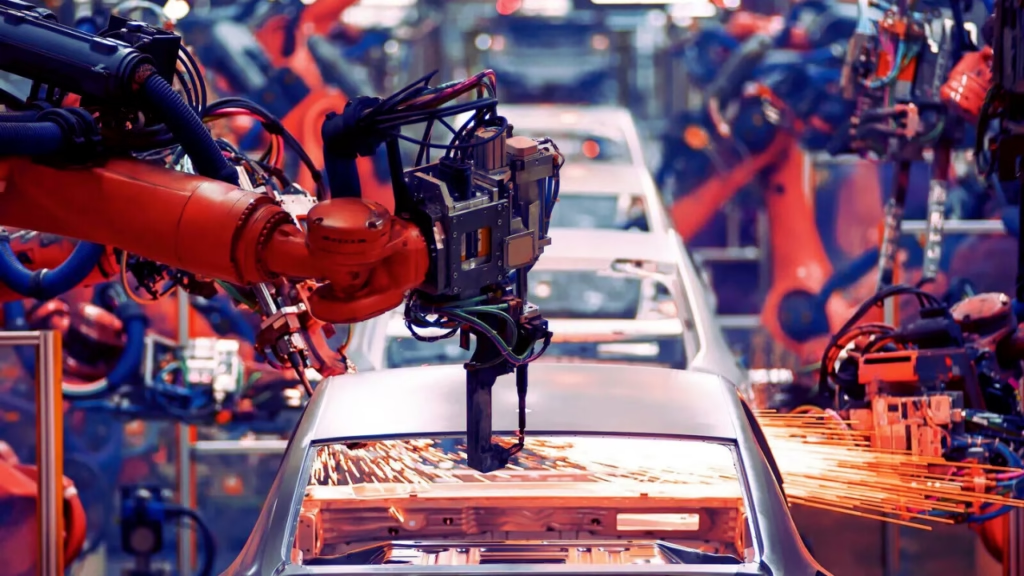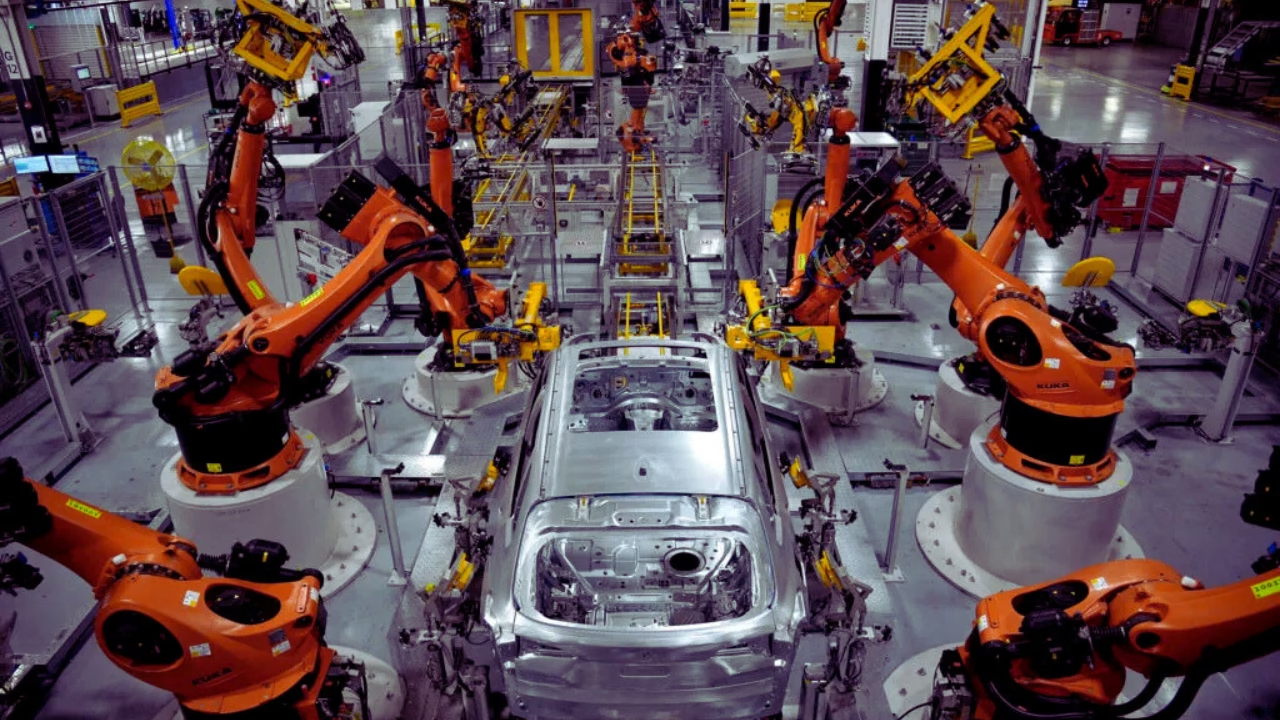Production technology is a driving force behind industrial progress, shaping the way goods are manufactured and delivered. It encompasses a wide range of innovations, from automation and robotics to artificial intelligence and digital manufacturing. These advancements have significantly improved efficiency, reduced costs, and enhanced product quality across various industries. The evolution of production technology has enabled manufacturers to meet growing consumer demands while maintaining sustainability and scalability. With Industry 4.0 leading the way, businesses are integrating smart systems, real-time analytics, and IoT-powered solutions to streamline operations. As a result, production processes have become more agile, precise, and resource-efficient.
Delves into the latest trends in production technology, highlighting key applications, benefits, and challenges faced by industries today. By understanding the impact of these advancements, businesses can make informed decisions to stay competitive in an ever-evolving industrial landscape.
Importance of Production Technology

Production technology is critical for fostering industrial growth and driving economic development. It enables businesses to optimize resources, reduce production costs, and boost overall productivity. With the integration of automation, robotics, and AI-driven systems, industries can maintain high-quality output with minimal human intervention. This technological advancement allows businesses to stay competitive in an increasingly globalized and fast-paced market. Additionally, production technology supports scalability, making it easier for companies to meet growing demand without sacrificing quality.
It contributes significantly to sustainability by minimizing waste, energy usage, and environmental impact. In turn, this leads to cost-effective, eco-friendly practices that align with modern business needs. Ultimately, embracing production technology helps companies thrive in a constantly evolving industrial landscape.
Increased Efficiency
Production technology enhances efficiency by integrating automation, robotics, and AI-driven systems. These advancements streamline manufacturing processes, significantly reducing the time and labor required to produce goods. Automation reduces human intervention, allowing for continuous, uninterrupted production. This results in faster output and higher throughput, benefiting businesses that need to meet high demand. AI-powered predictive maintenance systems also improve efficiency by preventing unexpected equipment failures, thus minimizing downtime. With real-time data analytics, businesses can identify bottlenecks, optimize workflows, and maximize productivity.
Cost Reduction
Production technology aids in reducing costs through better resource management, waste minimization, and reduced labor requirements. Automated systems decrease the need for large workforces while maintaining consistent production levels. Precision engineering and smart manufacturing techniques ensure that raw materials are used optimally, thus minimizing waste and saving costs. AI algorithms help businesses predict demand fluctuations, allowing them to adjust production accordingly to avoid overproduction or shortages. Energy-efficient machines reduce power consumption, further lowering operational costs.
Quality Improvement
Production technology plays a pivotal role in improving product quality through high-precision techniques and stringent quality control measures. Automated systems reduce human error, ensuring consistent, accurate output. CAD and CAM technologies enable precise production, enhancing uniformity across products. Real-time monitoring systems detect defects early in the process, allowing for immediate corrections and reducing the number of faulty products. Robotics and AI-based inspection processes ensure that quality standards are maintained by identifying even the smallest inconsistencies. Machine learning models analyze past production data to predict potential quality issues and prevent them. Automation in industries like electronics and pharmaceuticals guarantees high reliability and customer satisfaction, while innovations like 3D printing continue to refine the quality of products.
Flexibility
Modern production technology offers industries the flexibility to respond quickly to changes in market demands. Traditional manufacturing methods often struggle to adjust to consumer shifts, but advanced systems like 3D printing and modular assembly lines provide the agility required to scale production. AI-driven demand forecasting helps businesses anticipate changes in consumer preferences and adjust production levels accordingly. Smart manufacturing systems enable mass customization, allowing companies to create tailored products without increasing costs. Digital twin technology further enhances flexibility by allowing manufacturers to simulate new production processes before implementing them.
Sustainability
Production technology is a key factor in promoting sustainability by improving resource efficiency and reducing environmental impact. Advanced manufacturing processes help minimize waste by utilizing raw materials more efficiently. The use of energy-efficient machinery and renewable energy sources reduces the carbon footprint of industrial operations. Green manufacturing practices, including material recycling and reuse, foster a circular economy that supports long-term sustainability. AI-driven supply chain management optimizes logistics, reducing emissions from transportation and inventory processes. In agriculture, precision farming reduces water consumption and minimizes chemical use, making food production more sustainable.
Latest Trends in Production Technology
The latest trends in production technology focus on enhancing efficiency, quality, and sustainability. Automation and robotics continue to evolve, enabling more precise and efficient manufacturing processes. Artificial intelligence (AI) and machine learning are being increasingly integrated for predictive maintenance, reducing downtime and improving system performance. 3D printing is gaining traction for custom manufacturing and prototyping, allowing for greater flexibility and reduced lead times. The use of the Internet of Things (IoT) in production enables real-time monitoring and data analytics, optimizing workflows and minimizing waste.
Augmented reality (AR) is improving worker training and machine maintenance. Sustainability is a growing focus, with green technologies and energy-efficient systems becoming key priorities. These trends are reshaping industries making production more efficient, adaptable, and environmentally responsible.
Automation and Robotics
Automation and robotics are transforming manufacturing by replacing manual labor with precise, high-speed machines. Robotic arms and automated assembly lines increase production efficiency, speed, and accuracy while minimizing human error. AI-driven monitoring systems further optimize processes by analyzing data in real time This integration helps manufacturers reduce operational costs and improve product consistency. With robotics handling repetitive tasks, industries can focus human resources on higher-level decision-making and innovation.
Artificial Intelligence and Machine Learning
AI and machine learning are reshaping production technology by enabling predictive maintenance and real-time process optimization. Machine learning algorithms analyze large datasets to identify inefficiencies and improve production workflows. AI-driven systems can also detect quality issues early, ensuring higher product consistency. These technologies optimize resources and reduce unnecessary downtime, enhancing the overall productivity of manufacturing. With continuous learning capabilities, AI and ML help businesses adapt to changing demands efficiently.
Internet of Things (IoT) in Manufacturing
The Internet of Things (IoT) connects machines, sensors, and software for continuous real-time monitoring and control in manufacturing processes. IoT systems provide valuable data, helping businesses optimize production, improve operational efficiency, and reduce downtime. With IoT-enabled devices, manufacturers can track performance, detect issues, and make proactive adjustments to prevent disruptions. This enhanced connectivity leads to smarter decision-making and faster issue resolution, ultimately boosting productivity. IoT is a key enabler of intelligent, data-driven manufacturing operations.
3D Printing and Additive Manufacturing
3D printing and additive manufacturing offer significant advantages in rapid prototyping and custom production. These technologies minimize material waste by building products layer by layer, ensuring more efficient resource use. Industries like aerospace, healthcare, and automotive benefit from the ability to produce complex, tailored parts quickly. 3D printing also speeds up product development by allowing for rapid iteration and testing of designs. As a result, companies can reduce costs and accelerate time-to-market with highly customizable and precise products.
Emerging Technologies in Production
Emerging technologies in production include advancements such as AI-driven automation, IoT integration, and 3D printing. These innovations are enhancing efficiency, flexibility, and sustainability. AI and machine learning are optimizing manufacturing processes, while IoT enables real-time monitoring. 3D printing is revolutionizing prototyping and custom production, making industries more adaptable and cost-effective.
| Technology | Application Area | Benefits |
| Robotics | Assembly Lines, Warehousing | Increased Precision, Speed |
| AI and ML | Predictive Maintenance, QC | Data-Driven Decision Making |
| IoT | Smart Factories, Monitoring | Real-Time Insights, Connectivity |
| 3D Printing | Prototyping, Custom Parts | Cost-Effective, Reduced Waste |
| Blockchain | Supply Chain, Traceability | Enhanced Transparency, Security |
Applications of Production Technology
Production technology has wide-ranging applications across various industries, driving efficiency and innovation. In automotive manufacturing, robots and automation are used to assemble parts with precision, reducing errors and improving throughput. The aerospace industry relies heavily on 3D printing for producing complex, lightweight components, cutting costs and production time. In electronics, AI-driven systems help with quality control and predictive maintenance, ensuring consistent output. The healthcare sector uses production technology to manufacture medical devices and implants with high accuracy, often through additive manufacturing methods.
Consumer goods industries utilize robotics for packaging and assembly, enhancing speed and consistency. Additionally, food production benefits from automation, ensuring hygiene and optimizing processing times. These applications are making production systems faster, more sustainable, and adaptable to changing market demands.
Automobile Industry
In the automobile industry, production technology plays a crucial role in automating assembly lines, robotic welding, and implementing smart quality control systems. These technologies enhance the speed and precision of vehicle manufacturing, ensuring high-quality output with reduced human error. Automation allows for quicker production cycles, meeting growing market demands while maintaining consistency. Robotic systems are particularly useful in tasks like welding and painting, where accuracy is critical. Advanced quality control systems ensure every vehicle meets safety and performance standards, improving overall production efficiency.
Healthcare Sector
In the healthcare sector, advanced manufacturing technologies enable the production of medical devices, prosthetics, and pharmaceuticals with high precision. Automated systems help streamline the assembly of complex medical equipment, reducing the likelihood of human errors. Additive manufacturing, or 3D printing, allows for the creation of custom prosthetics tailored to individual patients. In pharmaceutical manufacturing, automation ensures that medications are produced consistently and meet regulatory standards. These technologies are critical in improving the quality, accessibility, and efficiency of healthcare products.
Electronics Manufacturing
AI-driven automation has transformed electronics manufacturing, optimizing chip fabrication, circuit board assembly, and semiconductor production. These systems improve accuracy and speed, enabling the production of complex electronic components at scale. AI algorithms are employed for real-time monitoring and predictive maintenance, ensuring minimal downtime. Automation also enhances precision in tasks like soldering and testing, which are critical to the functionality of electronic devices. As consumer demand for advanced electronics grows, production technology plays a vital role in meeting the challenges of mass production.
Food and Beverage Industry
In the food and beverage industry, production technology improves efficiency and hygiene standards through smart packaging, automated processing, and continuous quality monitoring. Automation speeds up processes such as sorting, packaging, and labeling, ensuring consistency in production. Smart sensors monitor critical factors like temperature and humidity, optimizing storage conditions and reducing waste. Additionally, automated processing lines enhance product quality while reducing human contact and improving food safety. These technologies are essential in meeting both consumer demand and regulatory standards while maintaining high levels of efficiency.
Textile and Apparel Manufacturing
In textile and apparel manufacturing, production technology has advanced with digital printing, automated sewing, and AI-based quality control systems. Digital printing allows for faster and more versatile fabric designs, reducing waste in the printing process. Automated sewing systems increase production speed while maintaining high-quality stitching and design accuracy. AI-powered quality control ensures that fabric defects are detected early, minimizing errors in garment production. These innovations enable greater customization, reducing the lead time for producing fashion items and improving the industry’s overall efficiency.
Challenges in Implementing Production Technology
Despite the numerous benefits, industries face several challenges in adopting modern production technologies. High initial investment costs for advanced machinery and automation systems can be a barrier for many companies, especially smaller businesses. Integrating new technologies into existing production processes may require significant adjustments, causing potential disruptions and downtime. Moreover, there is a shortage of skilled workers who can operate and maintain sophisticated systems, leading to additional training costs.
Data security concerns also arise with the increased reliance on IoT and AI systems, making companies vulnerable to cyber threats. Companies may also struggle to keep up with the rapid pace of technological advancements, leading to frequent upgrades. Finally, regulatory and compliance issues may pose challenges, particularly in highly regulated industries like healthcare and food production.
High Initial Investment Costs
One of the primary challenges in implementing modern production technology is the high initial investment required. Advanced machinery, automation systems, and AI integration can be expensive, making it difficult for many businesses to adopt these technologies. Smaller companies, in particular, may struggle to secure the capital needed for such investments. While these technologies offer long-term savings, the upfront costs can delay adoption. Additionally, companies need to factor in installation, training, and customization costs, further adding to the financial burden. Despite the potential for increased efficiency, these high costs often discourage businesses from leaping to more advanced production technologies.
Need for Skilled Labor and Technical Expertise
The implementation of advanced production technologies demands a skilled workforce with specialized knowledge. Many businesses face difficulties in hiring or training workers who possess the necessary expertise in operating sophisticated systems such as robotics, AI, and IoT. This skill gap can lead to inefficiencies and hinder the full utilization of these technologies. Companies must invest in training programs to ensure employees can manage, troubleshoot, and maintain these systems. Additionally, the constant evolution of technology means workers must continually upgrade their skills. The shortage of skilled labor presents a significant challenge to the widespread adoption and effective implementation of production technology.
Cybersecurity Risks Associated with Digital Manufacturing
As industries move towards digital manufacturing, cybersecurity becomes a major concern. The increased use of IoT, AI, and cloud computing in production processes opens up new vulnerabilities to cyberattacks. Hackers could potentially breach production systems, causing disruptions, stealing intellectual property, or manipulating critical operations. The need for robust cybersecurity measures becomes crucial as companies rely more on interconnected systems. Security breaches could not only damage a company’s reputation but also result in costly downtime and legal ramifications. With the rapid growth of digital manufacturing, companies must stay ahead of evolving cyber threats to ensure safe and secure operations.
Maintenance and Upgradation Expenses
Another challenge of implementing modern production technologies is the ongoing maintenance and upgrading costs. While advanced systems may offer improved efficiency and productivity, they require regular maintenance to avoid malfunctions and downtime. These systems often need specialized technicians for repairs, which can be costly. Additionally, as technology evolves rapidly, businesses may face the need to upgrade their systems frequently to stay competitive, leading to higher long-term expenses. Keeping up with software updates and ensuring compatibility with other systems also adds to the complexity. Over time, the cost of maintaining and upgrading these technologies can outweigh the initial investment, making it a challenge for businesses to manage their budgets effectively.
Future of Production Technology
The future of production technology is marked by the continued rise of smart factories that leverage interconnected systems for optimized operations. These factories will use advanced AI and machine learning to drive automation, reducing human intervention while improving accuracy and efficiency. With real-time analytics, manufacturers can make data-driven decisions to streamline processes and increase production speed. Sustainability will be a key focus, with industries adopting greener practices like energy-efficient machines, waste reduction, and the use of renewable resources.
The integration of digital twins will allow manufacturers to create virtual replicas of physical systems, enabling better design, monitoring, and troubleshooting. As these advancements evolve, industries will become more agile, scalable, and environmentally conscious, making production systems smarter and more efficient.
Smart Factories and IoT Integration
In the future, smart factories will become a cornerstone of production technology, integrating the Internet of Things (IoT) to connect machines, sensors, and systems in real time. This connectivity will allow for continuous monitoring and adjustment of operations to optimize efficiency. IoT will help improve predictive maintenance, reducing downtime and ensuring the longevity of machines. Furthermore, smart factories will enable automated decision-making, where machines can autonomously adjust their operations based on real-time data. This approach will create a seamless workflow with minimal human oversight required.
AI-Driven Automation and Robotics
Artificial intelligence will play a pivotal role in shaping the future of production technology. AI-driven automation systems will become even more advanced, performing complex tasks with high precision and speed. Robotics, empowered by AI, will handle more intricate and flexible tasks, from assembly to quality control, without requiring human intervention. These systems will learn and adapt to various production scenarios, improving efficiency and reducing errors over time. In addition, AI will enable predictive analytics, forecasting production needs, and potential failures before they occur, minimizing disruptions.
Sustainability and Green Manufacturing
Sustainability will be at the forefront of future production technologies. As environmental concerns grow, industries will increasingly adopt eco-friendly manufacturing practices to reduce their carbon footprint. Energy-efficient production systems will become standard, utilizing renewable energy sources like solar and wind to power operations. Green manufacturing techniques, such as recycling materials, reducing waste, and minimizing water usage, will help companies reduce their environmental impact. The use of AI and machine learning in optimizing production processes will further support sustainability efforts by identifying areas where energy consumption can be minimized.
Digital Twins and Virtual Prototyping
The adoption of digital twin technology will revolutionize the future of production. Digital twins are virtual models of physical assets, allowing manufacturers to simulate, monitor, and optimize processes in real time. This technology will be invaluable in designing, testing, and refining new products before physical prototypes are created, saving time and resources. With digital twins, manufacturers can predict potential issues in the production process and address them before they occur, minimizing costly errors. As the technology evolves, digital twins will become even more sophisticated, offering deeper insights into production systems and enabling more informed decision-making.
Real-Time Analytics and Data-Driven Decisions
Real-time analytics will play a significant role in the future of production technology, allowing manufacturers to make instant, data-driven decisions. By using advanced analytics tools, companies can monitor every aspect of their production process, from machine performance to supply chain logistics. These insights will enable businesses to identify inefficiencies, bottlenecks, and areas for improvement in real time. Additionally, data analytics will allow for better demand forecasting, reducing the likelihood of overproduction or stockouts. With the rise of big data, production systems will become more adaptive, with real-time feedback loops guiding continuous optimization efforts.
Adaptability and Customization in Production
The future of production technology will emphasize greater adaptability and customization to meet the ever-changing demands of consumers. Advances in additive manufacturing, such as 3D printing, will enable more flexible and cost-effective production of customized products in smaller batches. With AI-driven design and automated systems, businesses will be able to quickly shift production lines to create tailored products without significant retooling or downtime. This flexibility will allow companies to respond faster to market trends, enhancing their competitive edge. As consumer demand for personalized products grows, production systems will become increasingly agile, able to accommodate a wide variety of specifications and preferences.
Wrapping Up
Production technology continues to shape industries with innovative trends and applications. From automation and AI to IoT and 3D printing, modern advancements are driving efficiency and quality improvements. While challenges exist, the future holds promising developments that will further revolutionize production technology. With the rise of Industry 4.0, businesses are embracing smart manufacturing systems that integrate advanced data analytics and real-time monitoring. Sustainable production practices, such as energy-efficient manufacturing and reduced waste generation, are becoming priorities. Moreover, advancements in digital twin technology allow companies to simulate and optimize production processes before implementation, enhancing precision and reducing costs.
As industries continue to evolve, investment in research and development will play a critical role in driving future innovations. Governments and enterprises must collaborate to create policies that support the adoption of cutting-edge production technologies, ensuring a competitive and sustainable industrial landscape. The journey of production technology is far from over, and its potential to transform economies and societies remains immense.
FAQs
What is production technology?
Production technology encompasses the machinery, tools, and processes involved in manufacturing products. It is designed to improve productivity, reduce operational costs, and ensure high-quality output. By leveraging automation and advanced techniques, businesses can enhance their overall manufacturing efficiency. Production technology plays a vital role in optimizing resources, minimizing waste, and meeting industry standards.
How does automation benefit production technology?
Automation significantly enhances production by reducing manual labor, increasing operational speed, and ensuring precision. It enables manufacturers to streamline repetitive tasks, minimize human error, and lower labor costs. Automated systems can operate continuously, boosting productivity and reducing downtime. Additionally, automation allows for faster response times to market demands, improving flexibility.
What industries use production technology?
Numerous industries, including automotive, healthcare, electronics, food processing, and textiles, rely on production technology for optimizing manufacturing processes. In the automotive industry, automation and robotics improve assembly lines. Healthcare uses precision manufacturing for medical devices and pharmaceuticals. Electronics and food processing sectors benefit from AI-driven automation, enhancing product quality. Textiles adopt digital technology to improve fabric production.
What role does AI play in production technology?
AI plays a crucial role in optimizing production through real-time data analysis, predictive maintenance, and quality control. Machine learning algorithms analyze patterns in production data to predict potential issues before they occur, reducing downtime. AI can monitor manufacturing processes, ensuring product quality and consistency. Additionally, AI helps in automating decision-making processes, leading to faster and more accurate production adjustments.
How does IoT impact production technology?
The Internet of Things (IoT) connects machines and sensors, enabling real-time monitoring and data collection. This connectivity helps manufacturers track production metrics, improve workflow, and reduce errors. By analyzing data from interconnected devices, manufacturers can optimize resource allocation and improve operational efficiency. IoT also supports predictive maintenance by alerting managers to potential equipment issues before they cause failures.
What are the challenges in adopting modern production technologies?
While production technologies offer significant benefits, challenges in their adoption include high initial investment costs and the need for skilled labor. Many businesses struggle with the expense of integrating advanced systems, especially small and medium-sized enterprises. The demand for specialized technical expertise to operate and maintain these systems can be a barrier.
What is the future of production technology?
The future of production technology is characterized by innovations like AI-driven automation, sustainable practices, and the integration of digital twins. These advancements will enhance production efficiency, reduce waste, and improve product quality. Energy-efficient technologies and eco-friendly production methods will be crucial for meeting global sustainability goals. Additionally, real-time analytics and predictive technologies will further optimize production processes.








